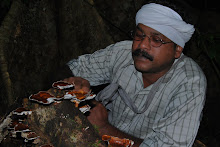
On 20, september of this year, during a butterfly survay at the Muthenga wildlife scantuary in waynad(Kerala), an unstriped caecilian (legless amphibian) was found under a piece of log, coiled around its eggs. The caecilian was around 45 cm long. The body was slaty brown above, lighter below. The position of the tentacle was just above the lip and closer to the eye than the nostrils. The first nucal groove was more prominent ventrally while the second was indistinct and visible only ventrally. Since the specimen was not disturbed around 44 eggs were counted. The eggs were transparent and the well developed embryo was seen moving inside the egg. The species was later identified as Ichthyophis bombayensis. Until recently 4 species of unstriped caecilians were known from the Western Ghats. Presently the DNA sequencing of these species revealed that the 4 species are closely related and the other 3 species(I.malabarensis, I. penensularis and I.
subterrestris) are now synonymised with Ichthyophis bombayensis.
subterrestris) are now synonymised with Ichthyophis bombayensis.
Though few of the other groups were able to sight Tigers, Leopards and other game animals, I consider myself to be extremly lucky to find this enigmatic amphibian coiled around its eggs in the wild. I agree that many of the large mammals are endangered and need to be conserved. But we should not forget the smaller, less conspicuous animals.

uv done a gud job vivek! but jus try 2 describe wat u men by those grooves nd al by d neck of it!
ReplyDeleteThats a real good luck..!! i have just read about the same. Caecilians are one of those beautiful species of amphibians that are yet to be studied.. There are very less records or photographs of these beings. I am glad i have one, and i am thankful to you vivek.
ReplyDeleteI still remember the previous expedition when we missed several numbers of them. I have understood how tough they are to find and how easy to let one go.
Anyways, this is one of the most rarity that you have documented.
Cheers..!!
Suhas
Vivek, you are really lukky.....no...no....its the intention of Ichthyophis bombayensis to expose itself to person like you, who has a sincere interest towards the conservation of them and lower vertebrates which are long been neglected....according to me this photo is explaining that " Please conserve us from habitat loss and fragmentation and give us an opportunity for continued survival on this planet earth". actually, it need not to request us, its the real habitat of those wildlife...We acquiring their home and destructing...its shame to us...its a right time to conserve them and make this earth long live...
ReplyDeleteHi
ReplyDeleteWe did spot a caecilian Ichthyophis family during the summer camp we conduct for kids at mudumalai. The picture is available here. Can you help in identifying which species is this?
http://www.frolicboonies.com/photos/displayimage.php?album=2&pos=63
Best regards
Bala